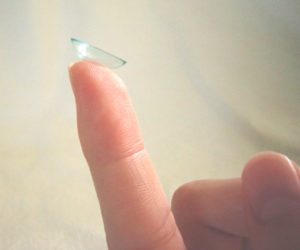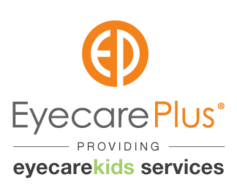Did you know that microbial keratitis—an eye infection caused by bacteria in the eye—is more common in people who wear contact lenses? Severe cases of microbial keratitis can lead to blindness due to significant scarring. Contact lenses directly touch our sensitive eyes, so extra care and best practices should be observed.
Whether it’s your first time wearing contact lenses or you wear them regularly, make sure you’re not doing these 35 bad habits:
 1. Handling CLs with unwashed hands.
1. Handling CLs with unwashed hands.
Why it’s bad: Germs from your hands can transfer to your CLs and to your eye. Wash your hands, rinse well, and dry your hands on a lint-free towel before handling CLs.
2. Letting tap water come into contact with your CLs.
Why it’s bad: Although tap water is treated and particles are removed, it is treated for drinking and not to be put on the eye. Tap water can contain bacteria, which is okay for consumption, however can cause infections in the eye.
3. Using saliva as an “emergency wetting agent.”
Why it’s bad: Your saliva is laden with bacteria that does not belong to your eye.
4. Not following the recommended CL replacement schedule.
Why it’s bad: CLs have been designed by the manufacturer for a specific wear schedule. Although your CL may seem and feel okay, the lens surface or material may degrade, leading to an increase in bacterial growth.
5. Reusing old CL solution.
Why it’s bad: All the debris and bacteria that you’ve cleaned off the lens is now in the solution. When you put another lens into the old solution, you’ve just put your clean lens into dirty solution.
6. Topping off old CL solution with a new one.
Why it’s bad: The disinfectant in the CL solution loses its efficacy over time, so the solution may not clean the lenses as intended.
7. Mixing different CL solution brands without your optometrist’s knowledge and approval.
Why it’s bad: Some CLs may react to a solution differently. This is the case with different types of solution being mixed as well. Any reactions the contact lens has will be microscopic, and you won’t even notice it until it causes an issue on the eye.
8. Using “generic” or “off brand” CL solution.
Why it’s bad: Each solution has a specific purpose, and we use a specific contact lens solution because we know it works better for a specific contact lens or better for a specific person. There is no one-size-fits-all solution.
9. CLs not fully covered in solution during storage.
Why it’s bad: If your contact lens is not fully covered in solution, then you’re not cleaning it properly. Fill your contact lens case 2/3 full of CL solution and place the lens into the case so that it is covered by the solution.
10. Overfilling the storage case with CL solution.
Why it’s bad: CLs generally float to the top, and if it touches the cap, it may get damaged by the lid.
11. Not closing the sink drain when putting on or removing CLs.
Why it’s bad: You may simply lose your CLs down the sink drain. With a daily disposable lens this may not be as important, but if you wear custom lenses, this may be a costly procedure.
12. Touching the tips of solution bottles or lubricating drops with your fingers.
Why it’s bad: If your hands aren’t clean, you may be putting bacteria onto the tip of the solution, which may cause the bacteria to culture in the solution.
13. Wearing the same CLs after they have become suddenly or consistently uncomfortable.
Why it’s bad: Discomfort, blurry vision or slightly red eyes are signs that there’s a problem with your CLs or you are having a reaction to something. If you continue to wear them, you risk having an infection.
14. Wearing CLs even when your eyes are swollen, red or infected.
Why it’s bad: If your eyes are red or swollen, then it’s an obvious sign that you’ve had a reaction to something. Covering it up with a contact lens is only going to make it worse.
15. Wearing a CL with a tear or chip in the lens.
Why it’s bad: This can scratch your cornea.
16. Picking up dropped CL using your fingernail.
Why it’s bad: Fingernails can scratch or tear the CL.
17. Not wearing protective eyewear when working in dusty environments.
Why it’s bad: Dust can get into the eyes and adhere to your CLs. Cleaning your lenses may not remove dust particles and may cause further reactions on your eyes.
18. Not rubbing your CLs during cleaning (even if you are using a no-rub solution).
Why it’s bad: CLs still develop a film even with no-rub solutions. Rubbing while cleaning is the best way to remove CL debris.
19. Using homemade saline solutions.
Why it’s bad: Saline solutions have no chemicals or products that remove bacteria, protein and oil deposits from the CLs, so they do absolutely nothing for you or your CLs.
20. Putting on CLs after applying cosmetics.
Why it’s bad: Makeup like foundations, mascara, eyeliner and eyeshadow can get onto your CLs, leading to discomfort or poor vision. Follow this order: Put in CLs first before putting on makeup, and remove CLs first before removing makeup.
21. Using waterproof makeup when wearing CLs.
Why it’s bad: When waterproof makeup gets on your CLs, it will bind to your CLs. Waterproof makeup requires an oil-based remover, which cannot be used on the CLs.
22. Applying eyeliner above the lower lash line.
Why it’s bad: Eyeliner may block the glands that produce the tear film and in turn may make CL wear more uncomfortable.
23. Operating the stove or cooking on the barbecue with CLs on.
Why it’s bad: Extreme heat exposure can cause your CLs to warp or dry out and make removal more difficult. Also don’t leave your CLs on hot areas like TV tops, window sills or under direct sunlight.
24. Storing CLs in the same storage case for longer than 6 months.
Why it’s bad: The number 1 cause of infection is having a dirty case. Not replacing your case every month increases your risk of moderate to severe keratitis more than fivefold.
25. Wearing CLs while swimming or entering a hot tub.
Why it’s bad: Seawater, pool water, lakewater and tub water can contain bacteria that can cause eye infections or reactions.
26. Wearing decorative CLs bought from unauthorised establishments.
Why it’s bad: A lens that has been purchased without a proper fitting may fit poorly, and the lens may not be up to the quality that is required in Australia. This can cause reactions or, at worst, infections.
27. Sleeping with CLs not meant for overnight wear.
Why it’s bad: Believe it or not, your eye requires oxygen, and a fair amount at that. If you wear CLs that aren’t meant for overnight wear, then you deprive the eye of oxygen, which can cause changes to the eye anatomy.
28. Not seeing your optometrist for regular CL and eye checks.
Why it’s bad: Regular CL examinations allow your optometrist to determine whether the lens is still suitable for you. In some patients the lens may work well, but a change in lifestyle may alter the tear film or environment, making the lens more uncomfortable and causing issues.
29. Using cream soaps to wash hands prior to putting in your CLs.
Why it’s bad: This can leave a greasy residue on your fingers that may adhere to the CL’s surface. Avoid scented or oily soaps, especially products containing lanolin and moisturising lotions. Avoid putting on lotion before putting on CLs.
30. Putting on lotion, hand creams, deodorants before putting on CLs.
Why it’s bad: These cosmetics can leave a greasy residue on your fingers that will bind to your CLs.
31. Sharing CLs with other people.
Why it’s bad: You don’t share underwear, so why should you with your contact lenses?
32. Not knowing general contraindications of CL wear and care.
Why it’s bad: What you don’t know can hurt you.Your optometrist will discuss the do’s and don’ts of CL wear and care. Don’t hesitate to ask them anytime you are unsure of something.
33. Using products not recommended by your optometrist to clean and disinfect your CLs.
Why it’s bad: Your optometrist makes recommendations of products that will work best for you and your CLs. If you use other products, they may work but in the long run might not be the best for your eye or CLs.
34. Putting in eyedrops for red eyes (like Visine) with your CLs still on.
Why it’s bad: Eyedrops, especially therapeutic eyedrops, contact drugs. These drugs will bind to the CLs, and every time you wear your CLs, the drug in the eyedrop will continually affect the eye.
35. Not having a backup pair of spectacles.
Why it’s bad: You need good vision to function effectively and safely. There will always be moments when you can’t wear your CLs (i.e., when you are sick, when they get lost, etc.), so a spare pair of spectacles is very important.
